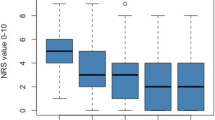Abstract
Pain research has shown that fear-avoidance beliefs determine disability from back pain to a significant degree. It is assumed that anxiety regarding certain movements or activities motivates avoidance behavior. It has not yet been established whether chronic low back pain (CLBP) patients actually experience fear of movement when confronted with back pain-related movements. Startle response measures reliably differentiate the affective quality of a stimulus. This study investigates whether CLBP patients show a startle response typical for aversive stimuli when confronted with pictures of back pain-related movements.
In 36 patients with CLBP, 18 headache patients and 18 healthy controls, the startle response was examined in the presence of pictures of back pain-related movements (e.g., bending) and pleasant movements (e.g., taking a relaxed position). Back pain patients did not show the predicted startle potentiation when viewing back pain-related pictures, although they rated these pictures as more aversive than did the other two groups. Results may indicate that it is not fear of pain that motivates avoidance behavior and determines disability, but rather an individual’s beliefs and attitudes concerning back stressing movements.
Similar content being viewed by others
References
Berg, K., & Balaban, M. T. (1999). Startle elicitation: Stimulus parameters, recording techniques, and quantification. In M. E. Dawson, A. M. Schell, & A. H. Boehmelt (Eds.), Startle modification (pp.21–50). Cambridge, England: Cambridge University Press.
Birbaumer, N., & Schmidt, R. F. (1996). Biologische psychologie [Biological psychology]. Berlin, Germany: Springer.
Bradley, M. M., Cuthbert, B. N., & Lang, P. J. (1999). Affective modification of startle. In M. E. Dawson, A. M. Schell, & A. H. Boehmelt (Eds.), Startle modification (pp. 157–183). Cambridge, England: Cambridge University Press.
Bradley, M. M., & Lang, P. J. (1994). Measuring emotion: The self-assessment manikin and the semantic differential. Journal of Behavior Therapy and Experimental Psychiatry, 25, 49–59.
Cook, E. W., Davis, T. L., Hawk, L. W., Spence, E. L., & Gautier, C. H. (1992). Fearfulness and startle potentiation during aversive visual stimuli. Psychophysiology, 29, 633–645.
Cook, E. W., Hawk, L. W., Davis, T.L., & Stevenson, V.E. (1991). Affective individual differences and startle reflex modulation. Journal of Abnormal Psychology, 100, 5–13.
Cuthbert, B. N., Bradley, M. M., & Lang, P. J. (1996). Probing picture perception: Activation and emotion. Psychophysiology, 33, 103–111.
Dolce, J. J. (1987). Self efficacy and disability beliefs in behavioral treatment. Behavior Research and Therapy, 25, 289–299.
Fordyce, W. E. (1995). Back pain in the workplace. Seattle, W A: IASP Press.
Grillon, C., Rezvan, A., Woods, S. W., Merikangas, K., & Davis, M. (1991). Fear-potentiated startle in humans: Effects of anticipatory anxiety on the acoustic blink reflex. Psychophysiology, 28, 588–595.
Hamm, A., Cuthbert, B. N., Globisch, J., & Vaitl, D. (1997). Fear and the startle reflex: Blink modulation and autonomic response patterns in animal and mutilation fearful subjects. Psychophysiology, 34, 97–107.
Hamm, A. O., & Vaitl, D. (1996). Affective learning: Awareness and aversion. Psychophysiology, 33, 698–710.
Kori, S. H., Miller, R. P., & Todd, D. D. (1990). Kinesiophobia: A new view of chronic pain behavior. Pain Management, 35–43.
Lang, P. J., Bradley, M. M., & Cuthbert, B. N. (1990). Emotion, attention, and the startle reflex. Psychophysiological Review, 97, 377–395.
Lang, P. J., öhman, A., & Vaitl, D. (1988). The international affective picture system. Gainesville, FL: Center for Research in Psychophysiology, University of Florida.
Lethem, J., Slade, P. D., Troup, J. D. G., & Bentley, G. (1983). Outline of a fear-avoidance model of exaggerated pain perception. Behavior Research and Therapy, 21, 401–408.
Linton, S. J. (1998). The socioeconomic impact of chronic back pain. Pain, 75, 163–168.
Mauler, B., Tuschen, B., & Hamm, A. (1997). Fear or craving: Startle reflex modulation during viewing of food cues in deprived and nondeprived bulimics. Psychophsiology, 34, 17.
McCracken, L., Gross, T., Sorg, P. J., & Edmands, T. A. (1993). Prediction of pain in patients with chronic low back pain: Effects of inaccurate prediction and pain-related anxiety. Behavior Research and Therapy, 31, 647–652.
Pfingsten, M., Leibing, E., Franz, C., Bansemer, D., Busch, O., & Hildebrandt, J. (1997). Fear-avoidance-beliefs bei Patienten mit Rückenschmerzen [Fear-avoidance beliefs in patients with chronic back pain]. Der Schmerz, 6, 387–395.
Pfingsten, M., Kroener-Herwig, B., Hempel, D., Harter, W., & Hildebrandt, J. (1999). Fear-avoidance Verhalten in Abhängigkeit von der Erwartungsinduktion [Fear-avoidance as depending on induced expectations]. Der Schmerz, 13, S81.
Philips, H. C. (1987). Avoidance behavior and its role in sustaining chronic pain. Behavior Research and Therapy, 25, 273–279.
Vlaeyen, G., Kole-Snijders, A. M. J., Boeren, R. G. B., & van Eek, H. (1995). Fear of movement/(re)injury in chronic low back pain and its relation to behavioral performance. Pain, 62, 363–372.
Vlaeyen, J. W. S., & Linton, S. J. (2000). Fear-avoidance and its consequences in chronic musculoskeletal pain: A state of the art. Pain, 85, 317–332.
Vlaeyen, J. W. S., Seelen, H. A. M., Peters, M., de Jong, P., Aretz, E., Beisiegel, E., & Weber, W. E. J. (1999). Fearofmovement/reinjury and muscular reactivityinchronic low back pain patients: An experimental investigation. Pain, 82, 297–304.
Waddell, G., Newton, M., Henderson, I., Somerville, D., & Main,C. J. (1993). A fear-avoidance beliefs questionnaire (FABQ) and the role for fear-avoidance beliefs in chronic low back pain. Pain, 52, 157–168.
Author information
Authors and Affiliations
Corresponding author
Rights and permissions
About this article
Cite this article
Kronshage, U., Kroener-Herwig, B. & Pfingsten, M. Kinesiophobia in chronic low back pain patients—does the startle paradigm support the hypothesis?. Int. J. Behav. Med. 8, 304–318 (2001). https://doi.org/10.1207/s15327558ijbm0804_5
Issue Date:
DOI: https://doi.org/10.1207/s15327558ijbm0804_5




